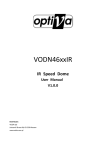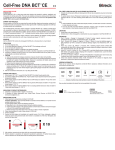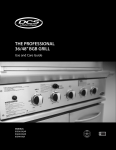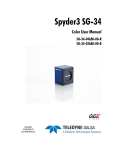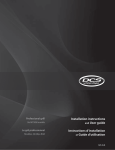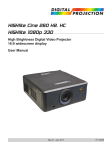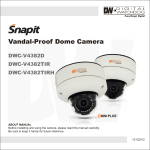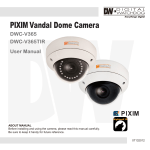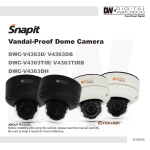Download User Guide Thank you for purchasing “Time & Space Color”(after be
Transcript
User Guide Thank you for purchasing “Time & Space Color”(after be referred to as “TSC”) color calibration card (hereinafter be referred to as “color card”) and color calibration software! You have entered a new world of color where color is no longer difficult to manage. You can automatically calibrate color according to our development process, capture and restore accurate colors from acquiring image to edit, to final prints, and to show you the perfect color reproduction philosophy, beyond the ultimate goal. TSC color calibration system is the world’ s first set of automatic color calibration system. It is a new generation of international standards instead of White balance. It contains a 45-color block color card and supporting software can meet the landscapes, figures, and even the highest level of remake works requirements. If the color card used with the software, it can help you create the perfect color effect. We believe TSC color card and its software will be your most valuable color management tools. This guide will briefly introduce you how to use this TSC color card for multi-purpose and its software. We also explained to you the specific steps on how to apply this powerful color calibration tools. Contents About Time & Space Color ·······························································································································3 Field of application············································································································································4 Technology Review ···········································································································································4 1. The relationships between light sources and chromatic aberration ································································4 The color rendering of the light source ············································································································4 Color temperature of a light source ·················································································································6 Light tristimulus values ····································································································································7 Uneven illumination ·········································································································································7 2. Questions of color distortion caused by the lens, film and digital recording devices: ·····································7 3. Why do we need the color management?·······································································································8 Light source selection and calibrations············································································································8 Cold cathode fluorescent lamp ··················································································································10 LED ( light emitting diode) ·························································································································10 Halogen light source ··································································································································10 Camera, scanner calibration ·······················································································································11 Output device calibration····························································································································12 TSC Color Card················································································································································13 1.About TSC full color calibration card ···········································································································13 2.Maintenance and Notice ······························································································································13 3.Lifetime ························································································································································13 Quality assurance label ·································································································································14 Limited by guarantee and warranty conditions ······························································································14 Shooting conditions········································································································································14 Studio, lab environment ·························································································································14 Outdoor shooting conditions ··················································································································15 Steps for taken with the camera·············································································································16 Software ···························································································································································17 I. Description of structure and function ········································································································17 1. Preparation before shooting ····················································································································17 2. Photography process·······························································································································17 3. Data processing procedures····················································································································17 II. Instructions ··················································································································································17 Installation ··················································································································································17 Login ···························································································································································17 III. The steps to use ·········································································································································18 1. To determine the best shooting light ······································································································18 2. Start to shoot after determined the best light ·························································································20 3. Light non-uniformity calibration··············································································································20 Specific steps of implementation ··········································································································20 4. Color Calibration····································································································································21 Values of color card ···························································································································21 Automatic color calibration ·················································································································22 IV. Improvement ···············································································································································23 Statistical error rate ································································································································23 Other improvement functions·················································································································23 SPECIAL NOTE ··············································································································································24 FAQs ·································································································································································25 1. Can you make automatic color calibration of the images to original? ···············································25 2. Is there any other automatic color calibration software in the world? ··············································25 3. Can your software be used in a variety of lighting conditions for calibration?································25 4. Do I still need to adjust white balance before using your color calibration system? ······················26 5. Can I use your automatic color calibration software with other’ s color card? · · · · · · · · · · · · · · · · · · · · · · · · · · · · · · · · · · · · 26 Contact us ························································································································································27 2 About Time & Space Color Time & Space Color (Suzhou) Information Technology Co., Ltd. is set up in Apr., 2011, targeting the color management and calibration. We developed a brand new three-dimensional non-uniform calibration algorithm for color calibration. TSC color calibration system, is the world's first automatic color management calibration system. Traditionally, digital scanning records using the white balance for color calibration. This method is only a two-dimensional relative calibration, and can not make the RGB three-dimensional calibration of each pixel on sensor records. The main research areas of TSC: Graphic image of the reading, identification, treatment technology Specifically, our solutions for high-definition ultra-large format image stitching including the perfect shape and color calibration of images (such as color consistency and accuracy etc.). TSC software has greatly improved the accuracy. It is a new international standard of color calibration instead of the white balance. Digital Library Technology Digital Museum Technology Our R&D team members are mostly masters and doctoral graduate, mainly from the UK UCL, Yale University USA, and other world-class schools, with rich knowledge in GIS (geographic information system) and image processing. Shortly we not only successfully developed the software, but also developed our own intellectual property rights of a Digital Photography laboratory, high-definition copy stand and many new products. Many high-end types of equipment are used in our laboratory such as Hasselblad camera, and Profoto lighting system, high-end graphics and other color calibration workstations. 3 Field of Application TSC Color Calibration Software (Hereinafter referred to as “TSC Software”) is the first automatic color calibration software. It is widely used in monitor, lighting, scanning, photography, video, publishing, manufacturing, astrophysics, and other fields with more stringent requirements on the colors. Mainly applies to: - Lighting equipment industry - Photographers, photography fans and Optical System - Color calibration for images recorded on digital cameras - Scanners - Electronics industry - Publishing - Printing and dyeing, painting, etc. Technology Review It becomes very difficult to make an accurate color reduction for a long time past due to the colors show different characteristics under a variety of lighting conditions, and different optical lenses, film, scanners, and CCD digital recording equipment has its defects. Even in the same lighting condition, it may cause color distortion due to the different color temperature conditions, as well as uneven and instable lighting (such as fluorescent flicker, etc.). Meanwhile, some lights are discontinuous spectrum lighting themselves, are missing some of the color, so it is very difficult to restore the historical color. Many well-known companies, competing to improve color reproduction of the device itself, but so far, even the world's best companies are still unable to make the color reproduction rate approach to 96% in a variety of photographic conditions. Accurate reduction is still the dream of many enterprises. 1. The relationships between light sources and chromatic aberration The color rendering of the light source We accustomed to distinguish colors under the sun, though it varies in different natural conditions as the color temperature of sunlight and spectral energy distribution changes, but people still can be accurately identified, resulting in the formation of the human brain the memory of natural light. With the development of lighting technology, many new light sources are exploited, such as fluorescent lamps, mercury lamps and other light colors. They are very similar to daylight, but there is a huge difference between the daylight on the spectral energy distribution, because some 4 wavelength ingredients of monochromatic light are missing from them. Since people observed colors under these lights are different as under sunlight, so caused the problem of color rendering. In different illumination, even on the same color, our eyes may have a different sense of color, so customarily we set the most accurate color of the object displayed under the sunlight. Then daylight as a standard reference for many artificial light sources such as incandescent, fluorescent, sodium and so on, the strength of capability to show of the same color is called the color rendering of artificial light sources. A measurement of the degree of color-shift an object undergoes when illuminated by a light source when compared to a reference source of comparable color temperature. Color rendering index (CRI) refers to a measurement scale that rates an artificial light's ability to accurately illuminate colors. High CRI numbers indicate a better ability to display colors (100 as the highest). In general, the color rendering of the light source is decided by spectral energy distribution. Continuous spectrum of light source such as sunlight and tungsten etc., have good color rendering. Incandescent light is assumed to have a CRI of around 100 so it will render all colors correctly. The Ra values Chart of the general color rendering index (CRI) of light source Index(Ra) Level 90-100 1A Color rendering Applications the color needs to be accurately restored Excellent 80-89 1B 60-79 2 the color needs to be correctly judged less demanding on the color General 40-59 3 20-39 4 low requirements on the color rendering no specific requirements rendering Poor on the color Few lights color rendering index Ra value can reach to 96, generally up to 90, was identified as high-color rendering light. For example, we record the exact color of a picture observed in sunlight, then we found the color changed under the high-pressure mercury lamp, the pink turns into purple. Blue will turns into black under the low-pressure sodium yellow light lamp. Generally the lower color rendering index means the color distortion is more severely. In the long-term practice, people use 450nm blue light, 540nm green light and 610nm orange light as appropriate ratio mixing to become white, while it’ s not a continuous spectrum, it has an excellent color rendering. All objects can be a good color effect under such white light. 5 Color temperature of a light source Color temperature is a standard method of describing colors, and it is normally expressed in units called Kelvin (K). The color temperature of a light source is determined by comparing the light source’ s chromaticity with that of a black screen. Color temperature is the most common indicators of spectral quality. And light source is generally expressed in Pa. It is the temperature at which a black screen discharges enough energy to generate a color equivalent that will generate an amount of light comparable to a color in the spectrum of visible light. If the low color temperature light source is characterized by red radiation in the energy distribution, it is relatively more often referred to as “warm glow”; the color temperature was raised, the energy distribution of concentration, increased proportion of blue radiation, often referred to as “cold light”. The general Color temperatures in the Kelvin scale 1930K- Candle Flame 2760-2900K- Household Tungsten Bulbs 3000K- Fluorescent Lamp 3800K- Flash 5400K- Sun: Direct at Noon 6000K- Electronic Flash 12000-18000K-Blue Sky In the black body radiation, different temperature give different colors of light, bold show from red orange –yellow- yellow& white-white –blue & white in a gradient process. The color temperature of a light source is the temperature of an ideal black body radiator that radiates light of comparable hue to that of the light source. The higher temperature of black body, the more blue composition of the spectrum whiles the less red component. For example, the incandescent light color is warm white, the color temperature is 2700K, and the color temperature of daylight fluorescent light is 6000K. Some discharge light sources emit light in color and black body temperature in a variety of colors of light emitted is not identical. So in this case we cite “correlated color temperature”concept. The color temperature of a black body radiator most closely matches the light from a light source is called CCT (correlated color temperature). Different color temperature of a light source, light color is different and also bringing the feeling is not the same. For example: <3300K Warm (white with red) stable, warm 3000-5000K Intermediate (white) readily >5000K Cool type (white with blue) Cold 6 Color temperature and brightness: Irradiation of high color temperature light source, if brightness is not high, people will have a cold feeling; while irradiation of low color temperature light source, the brightness is too high people will have a hot feeling. Comparison of light color: In the same space using two very different colors of sources light, there will be a level to compare the results; large contrast of light color the brightness level in the access to the same time, the level of light color is available. Light tristimulus values Ideally in theory, the natural white light from the primary colors of red, green, and blue is ratios of 1:1:1. The light is emitted by artificial light, mixed through red, green, and blue three monochromatic lights in different proportions. The light source which is used to match the needs of a particular red, green and blue primary colors are called the amount of light tristimulus values. Red, green and blue tristimulus values of light were represented by X0, Y0, Z0. The proportion of light color can be relatively clear to see the different color rendering properties from the table. The reason why some light sources tend to be yellow, warm, while others partial blue is because of the tristimulus values caused by the unequal distribution. Uneven illumination Light source is not perpendicular to the object, or several different light source to the same object, often result in uneven illumination. Non-uneven illumination may cause noise in the background of image, and mixed signal together, resulting contrast is not strong and the dark spots in image and impact of analysis and processing on the subsequent images. In summary, artificial light, as different color rendering and color temperature, even made a very big efforts, it is difficult to simulate close to 100% no chromatic aberration light conditions. 2. Questions of color distortion caused by the lens, film and digital recording devices: Optical lens will produce dispersion, color aberration and other issues. General optical lens with low spherical aberration, but relatively speaking, will be accompanied by a greater light scattering, which is chromatic aberration, mainly because of the visible light of different colors (red, blue and green, etc.) of different wavelengths through optical lenses of different refractive index, it can not be brought together in the same location, especially in the long focal length telescope lens, shorter wavelength of red, blue apparent cause dispersion easily, so the image sharpness and brightness of color greatly affected. Film exposure latitude is very narrow, the time when is need to adjust the exposure must also be forced to develop specially to get block one or two of exposure latitude, without image contrast and color shift. That is, when there is a need to improve the sensitivity, the first is to take an appropriate increase in time, the sensitivity of the exposure beyond the calibration to compensate, reduced 7 processing is the opposite. Digital recording device generally use of CCD, CIS, CMOS and other digital signal processing methods. Charge Coupled Device (CCD) is a semiconductor imaging device, which has a high sensitivity, anti-glare, less distortion, small size, long life, anti-vibration and so on. Contact Image Sensor (CIS), this digital signal processing methods often used by scanner. CMOS is the image sensor of digital photography, CMOS sensors can also be divided into passive pixel sensor and active pixel sensor, were widely used in mobile phones and other low-end digital recording equipment. The CCD, for example, despite of the area array CCD, linear array CCD, three-wire sensor CCD, interlaced transmission format CCD, All format CCD and other forms, recording methods such as RGB primary colors, CYGM complementary color, RGBE four-color, Super CCD, etc., but no matter What kind of recording method, manufacturers make the great efforts to restore the better color, but even the best cameras of several brands still have different degrees of chromatic aberration. 3. Why do we need the color management? Color management is a technology term refers to the process that color from input to output always keeps consistent. That is, using our eyes can identify the artificial light of the nearest natural light conditions, the corrected digital camera or scanner recording equipment to capture vivid colors, and display accurate color on screen, the last printer to print out the same image with the original landscape. As it involves so many input and output devices, to achieve this goal is indeed a challenge. Color management begins from the light, the camera. If there are no accurate light colors and the camera and scanning equipment can not capture the exact colors, such as uneven light, inaccurate color temperature, etc., due to many uncertainties, it is impossible to get copies of fully realistic counting on human eyes. At present, some high-end users such as museums, art reproduction and printing company etc., they already benefited from using color management in shooting, studio work, art reproductions and high quality pictures and so on. In particular, photographers may take of a large number of images with different camera, and then the usage of color management can keep them in same color effect. When in need to maintain consistency in editing a large number of images, such as shooting or producing catalog, can use TSC color card set up the same starting point for each image in the camera, program to group, and then use batch to minimize your workload. Light source selection and calibrations First, restoring and creating a perfect replica requires a very high standard in various links: There are strict requirements on selecting light sources, need to choose a light source very close to natural daylight. General, we recommend color temperature of light in range of 5000K~6500K; it has good color rendering and lower light non-uniformity. We do not recommend use of unstable sources (such as high color rendering fluorescent lamps, etc.), because all types of fluorescent lamps, 8 will inevitably produce fluorescent flicker, causing instability and uneven light on the picture. (See Illustration 1 below) (Ill. 1) Before After (Instability and uneven light on the picture) (Adopted TSC soft) TSC light homogenization software creates the best solution for the light non-uniformity. The methods that TSC used: First, shoot a white paper or other white coverings which must cover the whole lens, after shooting use the function of TSC software, comes out the effect of treatment. For further details and check the illustration 2 below: Meanwhile, even with an ideal light source, we also need to test light to find the best illumination, under the conditions of best color temperature and color rendering. Generally refers to the light source wattage. In general in the heterogeneity theory it will be the best to keep the incident angle was 45 º, if you use of dual-lamp lighting. 9 (Ill. 2) display an ideal light source position Note: General we recommended BH ratio as 1:0.8 ~ 1.2, and the ideal ratio which is 1:1. If you use flash light, the ideal illumination around the 1000Lx, the proposed light and shooting distance (H) is less than 2 meters. After above operation, we can collect data under an ideal light source. In order to get accurate restore in high standards and color reproduction, after tested, we recommended light source should be used, such as Broncolor, Profoto, Dyna-Lite, Speedotron Blackline brands, etc. TSC software provides the best light measurement solution by shooting a TSC color card under different output of the light source; the software will analyze the RGB values of color cards on which output power is the closest to the actual values, and then make the actual shooting. The use of light source in different distances and states (such as use of diffusers, cellular, filters, etc.) will produce different results. Before the actual shooting, we recommend to take measurement of light each time. There are three main types of light for scanner such as cold cathode fluorescent lamps, RGB tri-color light emitting diode (i.e. LED), and a small portion of the scanner used halogen lamps. Its characteristics are: Cold cathode fluorescent lamp Cold cathode fluorescent lamp has a small size, high brightness, long life, but required preheating before the work. Such light source has been widely used by flat scanner. LED ( light emitting diode) LED has a low noise, small power consumption, small heat, and without preheating, but the low brightness, slightly worse brightness uniformity, life-expectancy is relatively short (some CIS Scanner uses such sources.) Halogen light source Halogen lamps used in some high-end multi-plate scanners, as some film scanners, the brightness is very high, preheating time is short, and the maintenance, replacement is easy, but its heat is high, various aspects of using the function may be attenuation after a certain time. After our test, the result is even the most high-end scanners, few color reproduction rate can reach 95%, 90% has been quite good. For high-quality copying, printing, etc., even with the halogen source of light, can not achieve the most accurate restore. Printing industry generally use high-end electronic color separation, the color reproduction which can reach to 98%. 10 Camera, scanner calibration Due to different camera or scanner displaying different colors and the ways they capture colors differ by brand. Different lenses have their color characteristics; it will cause great trouble to mix different brands of cameras and lenses. In fact, even two camera or scanner made from the same manufacturers, the way of capturing the color may be different. User-defined configuration files will reduce the difference between the cameras, make the performance more consistent. According to our lab tests, different cameras all have some color cast, are often skewed in one direction, such as the number of Canon cameras for high sharpness, cool colors, while the some Nikon cameras of a partial warm. As the different light conditions, such as in the case of dim, color cast will add to the situation, it is difficult for some cameras for the color cast by loading a fixed direction of the ICC curve to be adjusted. Most digital cameras use a compound lens coating technology, such as anti-reflective coating (AR coating), re-evaluation of multi-layer coating, etc., but even the most advanced coating technology, the world's best camera, the problem of color cast exists of different levels. For camera calibration, generally synchronized with the light correction method, because the two are closely related, a single correction, and ultimately unable to get satisfactory results. Generally, we recommend camera and light source linkage shoot a TSC color card then using a combination of TSC software, can draw a calibration curve of reaction to the circumstances. For scanner calibration, the light CCD / CIS received, all from the lamp in the scanner itself. Impure or color cast of the light source, it will directly affect the scan results. Professional scanner, usually it will detect the light intensity automatically before scan, particularly in the start of scanner, because the lamp did not enter to steady state, it takes some time to preheat. When sufficient light reach to standard, the scanner to scan in the best working condition, then the detection sensor inside of the light through instruction before they start scanning. The average household, office scanners basically no self-test program, some light emitted by the scanner lamp or even not feel dazzlingly by our eyes, it is not enough to show shadow detail in the original in such a light intensity. TSC software can also provide the scanner calibrations. You just need to scan the TSC color card once, then TSC embedded software automatically read out deviations of each color, then used on all images that needs to be corrected on future. As we mentioned above, household and general business machines, because of the poor lighting conditions, and no light preheat such correction factors, light source is very unstable. For high-quality images, we advise you to scan TSC color card for start use each time, then calibrated by our software, we can start an official scan in the same conditions. Due to the incomplete defects and chromatography of the light source itself, we can not guarantee all files to achieve the perfect level of the situation as electronic color separation after used TSC calibration software, but, it will be an ideal image quality even if not with an ideal light source and scanning equipment.If you have any special requirements for our products, please contact us, we 11 can customize the color cards for you to make up the absence of colors in your light source, and support with special calibration program. Illustrate by examples: compare the results after tests by X-rite standard color card, through scanning, capture and after used TSC techniques respectively. to scan Color reproduction rate 50%~80% to shoot Color reproduction rate 70%~95% used TSC calibrate techniques Color reproduction rate >98% Output device calibration In order to ensure consistency with the original output, digital photo developing equipments and printing or printing output all needs the color management. Most color management software such as GMG, CGI, EFI, etc., mainly from the monitor to the digital output device (such as printer etc.). TSC color management and calibration software is compatible with other software, and is a necessary complement to them. It is often appears chromatic aberration in the end only from the screen output to the digital output device or printing press. It is really not enough just by these popular color management software which we mentioned before. As a good color management needs to be from the input devices (such as cameras, scanners, etc.) to the output device, which is the whole process of color management. Now TSC color calibration system provides you such a color management tool. In preparation of shooting, first take one picture of TSC color card to record the initial light source and value of camera shooting. Then shoot a white board card for calibrating uneven light. The last but not the least, under the same conditions starts shooting pictures. Upon completion of design and printing or print, output the earliest sample of color card; use our supporting TSC color reading device reads the print result, or print sample of color card input to the TSC color management system, which can analyze the color deviation and calibrate the image automatically. Currently, there is no one software in the world, truly making color calibration automatically; TSC software offers you an excellent automatic calibration tool. 12 TSC Color Calibration Card 1.About TSC Color Calibration Card Each color block of TSC color calibration card using pure tones and is colored individually, to produce realistic, consistent, bright colors and no outliers or variegated. TSC full color series calibration card made from main tone of RGB, gray value and exclusive complementary colors. Each color field divided into 9 segments basically covered the main color space. Used TSC color card, we don’t need to do white balance any more; the color can be most closely restored to the original by TSC software. General shooting, just take a TSC full color card before shooting portraits or landscapes in the same light. TSC color calibration software, generally can not calibrate inadequate lighting or overexposed photo, so before shooting, please use the light meter or camera’ s optical system measure the light. 2.Maintenance and Notice All colors made with special paint to achieve the full diffusion effect. When shooting at different angles, you can avoid being light reflective and complex problems. Keep it away from harsh natural environment and ultraviolet radiation. Please make sure your fingers do not touch any color blocks , hold the border only; Please keep it away from sunlight after the completion of operation, to prevent the long-standing of direct sunlight. The most destructive ultraviolet light of sunlight can cause the color patches fade. Please be careful that moisture and stains may destroy the target color card, Please gently wipe with a dry cloth or clean with an air blow. Do not use cleaning liquid for cleaning, this can damage the color blocks, use gentle detergent to scrub the back and border of the color card. 3.Lifetime 2-Year limited hardware warranty, but you must be careful to maintain in order to achieve this lifetime. A lot of outdoor use, especially exposure to sunlight or harsh environmental conditions, may shorten its lifetime. When not in use, please be sure to prevent excessive sun exposure. 13 Quality assurance label Our quality assurance is 2 years for normal use. Please mark the date of purchase at the back of the quality assurance label when in first time use, so it can remind you the date when to expire. The warranty period from the date of purchase, otherwise in the local laws and regulations (based on proof of purchase). Limited by guarantee and warranty conditions This guarantee is not limited to any region, and does not affect you or your TSC distributor (if you purchased the product directly from the TSC) may have legal rights. For your own interests, any support services that TSC provides are described in the explanatory materials, and the TSC technical support will make reasonable efforts, to help you solve any problems. If the product does not meet this guarantee, TSC will be (a) repair or replace the product or (b) refund the price you have paid (not including taxes or shipping charges). In the maximum extent permitted by applicable law, unless the guarantee provided, for consumers to use this software or inability to use the software for any resulting damages (including but not limited to special damages, indirect or incidental damage, which causes the business profits loss, business interruption losses, loss of business information or any other pecuniary loss), even if the TSC was told there is the possibility of damage, TSC and its distributors shall not be liable. If the product failure is due to an accident or you change, misuse or damage caused by discrepancies or defects, TSC does not undertake to correct, repair or take other compensation obligations. For users outside of China if failed to produce a non-authorized source of procurement purchases proved, not to provide such compensation measures. Shooting conditions Studio, lab environment There are strict requirements for the reduction of art reproduction, printing, museum records. In particular, large format, require multiple stitching images, attentions below for the shooting environment: 1. No stray light into the space, we general recommended opaque environment; 2. With 18% gray walls, ceiling color L <20, the ground using absorption materials (dark color carpet is recommended); 3. If two or a group of light be used, the shooting light and subject need to be taken in parallel. If dual-source lighting be used, then the incident angle was 45 ºas required. (Please check the picture below) 4. If you need to take more photos to stitching, the subject parallel to the camera and the camera has guide rail for parallel moving which is the best way to ensure consistency of recording. 14 Digital Photogrammetric Studio TSC hold 10 patent copy rights for this digital recording studio. Please contact TSC to get license for the technology and services. Outdoor shooting conditions TSC automatic color calibration system, mainly for calibration of the ideal light conditions, when engaged in outdoor shooting, you may need a light meter or the light measuring optical system comes with camera measured to ensure accurate exposure. Meanwhile, TSC color calibration system, there are relatively strict light requirements, general illumination is insufficient and too strong light conditions will greatly affect the calibration results. 15 Steps for taken with the camera: Operate steps for indoor shooting in high demand: Step 1: Firstly you need to do a test of light conditions: If you use flash photography, please place the TSC color card in the required shooting position, then adjust the light control box, start to shoot from the highest output power to the lowest. Note: please do not let the color card fills the viewfinder, leaving the edge of the card to read the four intersection of white cross-line, and record file names of each shoot corresponding to the intensity of light. Step 2: After taken this group of photos of the color cards, import to TSC software, then the computer will analysis the data of color cards and find out which is the closest to the default values under this shooting condition. Only when the data is the closest to the default value, then we can obtain the best calibration results. Step 3: Take a white paper or white board before start shooting (As shown) Step 4: Shoot TSC color card under the same condition. (As picture displayed) Step 5: Start to take a picture or a group of pictures. (As shown) Step 6: To calibrate using TSC color calibration software. Shooting a white paper or white board for the light uniformity processing of TSC software, and take photos of color card is the first step to obtain consistent, predictable color. For outdoor shooting, it can be started from the fourth step, if in a good light conditions. 16 Software TSC color calibration software operation manual I. Description of structure and function 1. Preparation before shooting For professional photography, many users often use electricity to drive the flash shooting to achieve the best reduction. But in general the light source and the subject according to different distances, there are many different powers can be adopted. Our software offers you the best value determination function of the light. The principle is that the output power in different circumstances, the shooting of our TSC-CCC color card, each color value can be obtained under each picture taken, compared with the default values, our software calculate the nearest value, the reduction of the ideal light. Our software also provides the light non-uniformity Calibration. The principle is to take a picture of our exclusive white card which has whole diffuse effects, by compare of the situation of light in different locations, find the uneven distribution image, and then use our software to be calibrated. The completion of above two steps of preparation then can start the formal shoot. 2. Photography process We recommend that the light with the camera to keep in fixed position when you shoot, the distance between the object is constant, and, the target within the range of the lens. We suggested that you start again from the first step, if any aspects of the original conditions changes. 3. Data processing procedures Shooting is completed, to output data, in order to ensure the accuracy to capture the data; we recommend the TIFF format for storage and processing. See in detail later on how to processing uneven lighting, the best source of determination, and manually adjust the color calibration and so on. II. Instructions Installation 1. Currently our software supports Windows XP, Vista, Windows 7 and other operating systems, if your system meets the above conditions, please insert the CD into CD-ROM drive. 2. Follow the instructions on the screen to complete the installation. 3. After installation, no need to restart the computer, the program can directly run. 4. Your computer needs to have 300MB disk space to install our software. Login Before you start using TSC color calibration software, you need to install a Dog driver at first, and then inserted the Dog into computer or laptop USB port after the installation was successful. 17 III. The steps to use 1. To determine the best shooting light a. Place color card in the center of lens, after determine the location of a good shooting light and the distance between the cameras. If you use lead flashing electric boxes, according to the flash output frequency (or Watts) from low to high or high to low, shot several group images of color card, and record the sequence of pictures corresponding to the output frequency of the light. b. Finish shooting, output the images to the computer then import to our software in our supporting format such as tiff, bmp, jpg etc. Then open one picture out of the images in our TSC software, go to the top under the tool bar select “Analyze”then click the “Best Light Source Analysis”or go to the menu bar click the icon “ ”, then it appears a hint “Please click the four intersection of white PLUS Symbol (“+”)”then you click the intersection. When you finished this step, the color blocks can be automatically cut out from this picture. After completion of the dialog box follow the step as above picture shows, and then click “Add 18 Images” button to add all images need to analyze, click “Start Analysis”, the program will automatically analyze and gives the result on which frequency is the best light to shoot, the result comes under the name of the color card. So we recommend each image of color card named as their corresponding flash frequency, it will very helpful to find the picture with the best light frequency. 19 2. Start to shoot after determined the best light Make sure the camera, light source and the subject keep the same location, and in the same shooting conditions, set the best light frequency as above we analyzed, then we can carry out shootings. After completion of shooting, output these sets pictures with the first image of color card, input to our software of the format which we can process. (Here we recommended TIFF format) If you use a fixed volt light or it is not with an electrical box to flash, then the steps can be omitted to determine the best light, only need to adjust the position of the light source and camera, and then start a series of shooting and format all pictures into the software in which it can handle. 3. Light non-uniformity calibration Generally if two lights and the camera placed asymmetry, or the lights and the subject was not placed as 45 ºangle, there will be problem of photos taken with the light non-uniformity (i.e. uniform of brightness and darkness), look at the photographs, it can be seen clearly in the partial light and dark. Traditional methods using image processing software (such as Photoshop), an overall reduction or increase of image brightness, the results of the brightest part of the original picture is still bright, and the dark place is brighter than before, but relative to the bright part, the contrast is still evident. TSC software provides Non-uniformity Light Calibration solution which can appropriate treatment for various parts of the bright and dark, to achieve the uniformity light of the whole picture. Specific steps of implementation 1) Before the official shot, shooting a pure white board (which TSC offered), requiring no stains and other debris on the board, and the best is on the whole non-reflective diffuse surface. 2) After completion of shooting, start the TSC software, click “File” under the Menu, select “Import”under the Sub-menu→ then to “White Card Board Image”, input the image of white card to the software, and then turn on the image which you need for non-uniformity calibration, click on “Edit”then go to the option “Non-uniformity Light Calibration”, the software will automatically calibrate for in-homogeneity of the light based on the background image which is input to the software to achieve the uniform light. It also can be repeated as your needs. 20 4. Color Calibration Color calibration function includes values of color card and automatic color calibration two parts. Values of color card Open the image of color card which was taken in the best light, click on “Edit”→ “Cut Color Card (manual) ”or go to menu bar click the “ ” button, a hint comes out “Please click the four intersection of the white PLUS Symbol (“+”)”, follow the direction to click the four intersection, then it will run automatically to cut off the excess. In addition, we can also use automated methods to cut the color card. Click on “Edit”→ “Auto Color Calibration”or click the menu bar of the “ ”button, the software will automatically cut off the excess part. When finish cutting the color card, go back to tool bar under “Edit” → to select “Mosaic Color Blocks”or go to the menu bar click the icon “ ”, the software will automatically value for each identified color blocks in the RBG model, wait for few seconds then select the option “View color blocks” or go to the menu bar click the icon“ ” to check whether the color card being cut out normally. If it looks unusual or has black edging, please repeat above steps operating it again. 21 Automatic color calibration Only when the result shows in the normal, then we can open the images which need to be calibrated. Click on “Edit”→ select the option “Auto Color Calibration”or go to the menu bar click “ ”button, it will run automatically. If the large number of pictures needs to be processed, then the function of “batch”can be used under the menu of “Edit”. (Picture displayed as below) Users can set their own parameters such as save as, reset size or rename etc. according to different requests. Before After By using TSC software, we can obviously to see colors of the picture are closer to the real object after calibration. 22 IV.Improvement Any software can’t make one hundred percent of the color reduction, in order to get better picture, TSC software provides more functions for our user such as statistical error rate, setup user-defined Color Adjustment function etc. Calibration Statistics Repeat above “Automatic color calibration”step in Color Calibration, if the results are in normal, click on the “Analyze”function tab to select the option “Calibration Statistics”or go to the menu bar click “ ”button, the software will automatically give a statistical reports of error rates of their calibration before and after. Other improvement functions If users would like to use Navigator to calibrate the color of image after the automatic calibration, we provide the options of Color Adjustment - fine tuning function to add or subtract of each color channel, Histogram, Black /White Enhancement and other image processing functions on common use such as sharpen and others in order to achieve the best restore effects. We provide 4 solutions for color adjustments to further improvement; users can choose the solutions based on their needs or adjust a band of color values of any proportion in experience to achieve the satisfactory results. 23 SPECIAL NOTE: 1. When shooting, please first make sure all color settings and contrast inside the camera set to default values, and be careful not to set the option of sharpen, because this will affect the color of shoot. 2. To ensure uniform distribution of light to the surface of color card, not to appear half-light situation, we recommend to use of dual light sources is the best, and to keep 45ºincident angel from the light to color card respectively. 3. For outdoors shooting, be sure to capture images in the same lighting conditions, and using the color card to restore the image, ensure that all color blocks fill in the camera lens. And it is located in a representative part of the composition and not in the shadows or in the high-beam position of over-exposure, thus it can avoid the reflective color to project on the color card, to reduce the color deviation. 4. Each color card with magnetic, it can be adsorbed on the ferrous material wall or board. 24 FAQs 1. Can you make automatic color calibration of the images to original? Yes. Our software and supporting color card can make it possible. Our color calibration technology is based on a large number of experiments. This new technologies was developed by our new algorithm. Specifically, you need to take a picture of our standard color card, then under the same conditions to complete shoot, after that import these two groups of pictures into our color calibration software, follow our demo, the color of images can be automatically calibrated. The principle is: we provide standard value for each color block of color card, after reading the values of color blocks by our software, compared with the default standard color values, concluded a color difference value, then according to the calibration curve to correct the distorted color of the picture. 2. Is there any other automatic color calibration software in the world? No. In fact, there isn’t actual automatic color calibration software in the world. Most camera, in order to capture the true color, use white balance to approach, which is shooting a white card, or take a 18% gray card (Lab values = 50), and then according to the gray value adjust value under the setup menu. Although this way can restore the color to the right direction, but only a simple linear calibration can not fundamentally restore the color. We know that all colors make of “RGB”three primary colors, it’ s a three-dimensional synthesis, is characterized by a spatial surface, so it’ s far from enough to only calibrate gray value of the overall translation. Some world-wide international companies, such as American X-rite, has begun using color cards to provide reference for calibration manually, and through calibrate images by using DNG to default the value of RGB for the camera lens, but this is not automatic color calibration in a strict sense. 3. Can your software be used in a variety of lighting conditions for calibration? No. Our automatic color calibration software calibrate only for right exposure under standard lighting conditions, the general range of 20% of calibration, it can be completely automatic calibration for 25 RGB values and gray value. But for lack of exposure, or over exposure such as under particularly dark light or bright light, can not be automatically calibrated. It was no sense using our software to calibrate images shot under over-exposed condition, because it makes the image over black, the RGB value was read by the computer already close to 0, and the value of some parts has already reached the maximum of 255, then the screen appears gray color block. On the other hand, if under-exposed, the color drift will appear the same effect. Therefore, we suggested that set a bound value or adjust manually to achieve the best visual value when light conditions are not ideal. 4. Do I still need to adjust white balance before using your color calibration system? No. In fact, our software provides an alternative to the standard white balance for the next generation of Color Calibration. Our color calibration system includes the correction of the gray value, and compared with normal white balance calibration, the principle is according to gray value to make a simple translation. Even if gray value drift as our principle, we have made a Pitch, Roll, Yaw or Scale several other three-dimensional space drift, which would be the most accurate reduction, not like white balance simply made a step of color translation. 5. Can I use your automatic color calibration software with other’s color card? No. We do not recommend that, the reason is our program has built in default value, but other’ s color card with different values. For example, we mentioned before that American classic X-rite color card, is not uniform after analyze of its RGB value; and it’ s almost no value in the range of 0-100, that is, if adopt this color card; we can’t get accurate data for calibration. Therefore, we strongly recommend that only using our software and supporting card for color calibration. 26 Contact us Time & Space Color (Suzhou) Information Technology Co., Ltd. Sales Office Address: Rm.509, 838 Zhong Shan Rd(N), Shanghai, China Postcode: 200070 Tel: 0086-21-56557622 Fax: 0086-21-56557622*8016 Email: [email protected] URL: http://cc.timspaceprofile.com (Chinese only!) 27



























